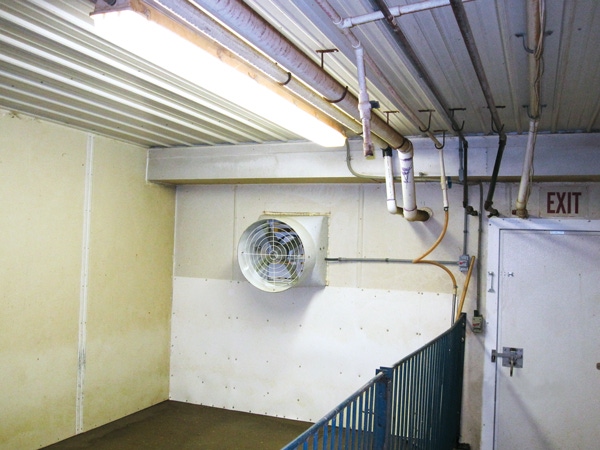Research Review: A Prairie Swine Centre research team assessed ventilation system designs in sow gestation rooms.
December 18, 2017

Ventilation affects many aspects of the animal environment, as well as barn operating costs, specifically energy. Retaining the existing ventilation system in a converted group-housed sow barn leads to overventilation during winter because the existing minimum-ventilation fans are designed for higher animal density, thereby using extra heating fuel and most likely chilling the animals and affecting their performance.
According to Harmon et al. (2010), if ventilation is continued at the pre-remodeling level, the building would be overventilated by about 33%.
An estimate of energy use for an overventilated facility indicated that overventilating by 30% can raise heating energy consumption by 75%. During summer, the impacts are less pronounced, but overventilation will use extra electricity, which translates to higher electricity cost. Also, the transitioning of the ventilation system design from stalls to group housing is not simply reducing the ventilation rate. It requires careful reconfiguration to ensure proper air distribution throughout the room to eliminate dead spots and unwanted drafts.
Quality air exchange key to good health
Air exchange is critical to providing a healthy environment that fosters efficient pig growth by reducing humidity and noxious gases like ammonia and carbon dioxide.
Since underventilation creates an unhealthy environment and overventilation wastes valuable heating and electrical energy, finding the right balance is the key to a healthy environment for both animals and workers, as well as to energy savings and efficiency. This balance can only be achieved by careful redesign of the existing ventilation system of a converted gestation barn.
Using computer simulation, a Prairie Swine Centre research team assessed ventilation system designs in sow gestation rooms. In this project, a numerical computer simulation technique — which used computational fluid dynamics to simulate fluid flow, heat and mass transfer numerically, and mechanical movement — was used to examine various design configurations and determine the most effective design of the ventilation system for a converted group sow housing facility under winter and summer conditions.
The ventilation system design parameters investigated included capacity and location of exhaust fans, along with size and location of air inlets. These two parameters were configured in such a way that the resulting ventilation system design followed the principles of either an upward airflow, downward airflow, or horizontal flow ventilation.

The control room has the unmodified ventilation system, while the treatment room (inset) has air inlets on the opposite side following the principle of a horizontal-flow-ventilation system.
Take-home message for producers
Results from the computer simulation have confirmed the need to redesign the ventilation system of newly converted group sow housing facilities. Among all the design configurations tested, horizontal-flow ventilation systems were the most effective in removing heat from the animal occupied zone during both summer and winter.
In-barn evaluation of the horizontal ventilation system design showed a 21% reduction in natural gas consumption during heating season and a 14% reduction in electricity compared to the unmodified ventilation system.
The horizontal ventilation system design for group sow housing provides better air quality and cleaner floors than the unmodified ventilation design. Carbon dioxide levels are good indicators of air quality. In both the summer and winter trials, the treatment room had much lower concentrations of carbon dioxide than the control room.
Horizontal ventilation increases sow comfort
Regarding behavior and welfare, enrichment use was greater in the room with the horizontal ventilation, which implies that sow comfort was better in the treatment room. Animal performance and productivity were not adversely nor beneficially impacted by having a horizontal flow ventilation system in a gestation room.
During the heating season, the horizontal ventilation system displayed a 21% and 13% reduction in natural gas and electricity consumption, respectively. During cooling season, a 12.6% reduction in electricity consumption was observed in the horizontal ventilation room. This translates into, on average, $1.60 in pig savings at current energy prices.
Researchers: Bernardo Predicala, Alvin Alvarado, Richard Baah, Jennifer Brown and Jingjing Cabahug, Prairie Swine Centre. For more information, contact Predicala.
You May Also Like



